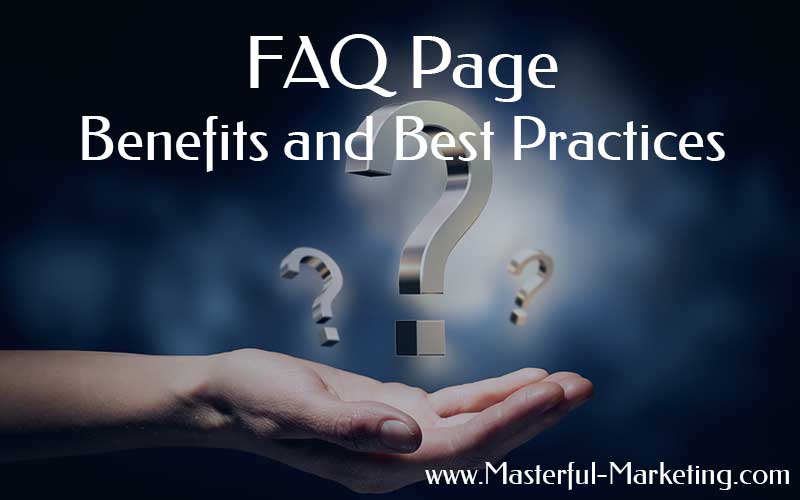
It’s no surprise that customers and visitors to your website have questions about your business, product or service that need to be answered. And we try to answer those questions through our blog posts and page content. But often the visitor needs a simpler way to find the answer they are looking for. A frequently asked questions or FAQ page is a place for visitors to easily find answers to their questions in one place.
There are many benefits to having a well-crafted FAQ page or section of your website that answers specific questions about your product or business. It can:
- Establish trust by showing the customer that you understand the challenges they face and how you can help
- Improve customer service by answering common questions
- Save you time and money by reducing the number of repetitive calls and emails to your support staff.
- Enhance your visibility in search engines
- Improve the user experience by making it easy to find what they are looking for rather than search the site. Linking the answers to blog posts or content pages directly makes getting additional information easier for the visitor.
- Demonstrate product expertise and strengthen your expert reputation
- Convert visitors into customers
If someone is reading the FAQs on your website, they are most likely evaluating your company’s products and services. Make sure you help their decision process by giving them clear answers and additional in-depth, easy to find content.
Where to put the FAQ page or section
It is important to put the FAQ section prominently on your website where it makes the most sense. Make it visible where it matters most: i.e. when they are considering a purchase or when they need support.
- Put customer service questions in your support section. You might also consider creating a support center and knowledge base for visitors to check first before submitting their question online.
- Group product questions and include the FAQ directly into the specific product pages to make them easy to be found.
- Link service questions FAQ directly in your main website navigation.
The FAQ page should not be an afterthought, nor should it be a solution to a poorly designed website. If you are redesigning your website, consider your FAQ as part of the overall design.
Recommended for You
How to structure the FAQ section
There are several ways to structure your FAQ section depending on the types of questions you need to answer.
If your questions cover a single topic, create a single, powerful FAQ webpage that is optimized for visibility.
If your questions cover several products or services, create a FAQ section on your website. This would include a main FAQ webpage listing all the questions that are then linked to separate landing pages optimized for specific search queries. This has several benefits:
- Group questions within themes or services areas to help your visitors find the relevant answers to their challenges. This eliminates them having to scroll through non-relevant questions looking for what pertains to their situation.
- Link each answer to a specific page or blog post that provides more information to help visitors learn more and search engines navigate and index your content for their relevant keywords.
- Lower the chance of people clicking the back button quickly by organizing your questions and answers into specific pages to avoid a very long, boring webpage.
In addition, there are several FAQ WordPress plugins that structure the FAQ with clickable questions that open up to reveal the answers in an accordion fashion.
Tips to Improve your FAQ Pages
Your FAQ webpage should enhance your visitor’s experience with your brand.
- Research what your customers really want to know and organize those questions and answers logically, using multiple pages if needed. This will create a better user experience and search engine visibility.
- Structure your FAQ section so that it is easy to navigate and visitors can immediately jump to the questions that are relevant to their concerns.
- Order your questions logically, starting with basic common questions and progressing to more complex issues.
- Add images and video to your FAQ page when appropriate. Sometimes visuals answer the question faster and more concisely than words.
- Be sure to deep link from the answers into your website pages and posts to provide additional information for the visitor and better indexing for the search engines.
- Keep your answers clear and simple, avoiding technical terms and jargon. Phrase the questions as your customer would ask them. Link to additional information in blog posts or other content pages to help those interested in getting more information do so easily.
- Keep the FAQ section up-to-date, adding new questions as they arise and updating the answers to existing questions if necessary.
- Don’t be afraid to answer the tough questions about your process, payment and terms of service.
- Include a call to action question to help the prospect know how to get more details, contact you or buy your products and services.
Visitors always have the need for an easy to navigate repository of answers to common questions. Make that experience pleasant while strengthening your reputation as a transparent and trustworthy business. Build trust with visitors and customers and they will more likely move through your conversion funnel.
